The oil and gas analytics market is projected to expand from USD 11.1 billion in 2025 to USD 103.6 billion by 2035, registering a CAGR of 25.0% over the forecast period.
In the first phase, the market grows from USD 11.1 billion to USD 36.9 billion, adding USD 25.8 billion. This surge is fueled by oil and gas companies adopting advanced analytics for asset optimization, production forecasting, and predictive maintenance, alongside pressure to minimize downtime and reduce operational costs.
In the second phase, the market accelerates from USD 41.7 billion to USD 103.6 billion, an increase of USD 61.9 billion. This stage reflects large-scale deployment of AI, machine learning, IoT-enabled platforms, real-time reservoir monitoring, advanced seismic data processing, and integrated supply chain analytics. Digital twins and cloud-based systems enhance decision-making across upstream, midstream, and downstream operations.
By 2035, analytics also become a core enabler of energy transition strategies, supporting carbon tracking, hydrogen production, and renewable integration. Oil majors and independents invest heavily to improve regulatory compliance, optimize production in volatile pricing environments, and strengthen long-term profitability.
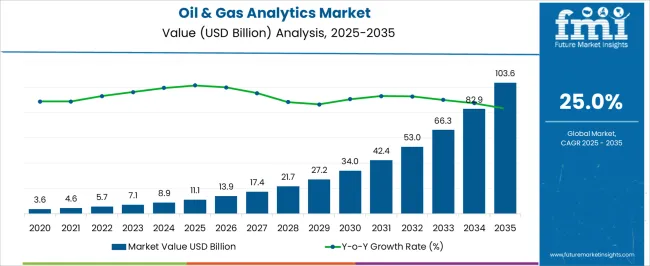
| Metric | Value |
|---|---|
| Oil & Gas Analytics Market Estimated Value in (2025 E) | USD 11.1 billion |
| Oil & Gas Analytics Market Forecast Value in (2035 F) | USD 103.6 billion |
| Forecast CAGR (2025 to 2035) | 25.0% |
The oil and gas analytics market is expanding as companies focus on optimizing operations and enhancing decision-making across the value chain. The need to efficiently manage exploration, production, and reservoir performance has driven the adoption of advanced analytics solutions.
Industry discussions have highlighted the increasing use of data-driven insights to reduce operational costs, improve safety, and maximize asset utilization. Developments in big data, machine learning, and cloud computing have accelerated the deployment of analytics platforms capable of handling large volumes of complex data.
Additionally, stringent regulatory environments and market volatility have motivated companies to adopt predictive and prescriptive analytics for risk management. The future outlook is promising as operators continue to invest in digital transformation initiatives and seek integrated analytics across multiple operational stages. Segmental growth is expected to be led by On-premise deployment models, upstream application areas, and professional services focused on consulting and integration.
The oil & gas analytics market is segmented by deployment, application, service, and geographic region. By deployment, the market is divided into on-premise and hosted. By application, it is classified into upstream, midstream, and downstream. By service, the market is segmented into professional, cloud, and integration. By region, the oil & gas analytics industry is categorized into North America, Latin America, Western Europe, Eastern Europe, Balkan & Baltic Countries, Russia & Belarus, Central Asia, East Asia, South Asia & Pacific, and the Middle East & Africa.

The On-premise deployment segment is projected to hold 52.8% of the oil and gas analytics market revenue in 2025, remaining the preferred deployment model. This segment benefits from its ability to offer greater control over data security and integration with existing enterprise systems.
Oil and gas companies have favored on-premise solutions for their critical infrastructure and compliance needs, ensuring sensitive data remains within internal networks. The flexibility to customize analytics platforms according to specific operational requirements has also supported growth.
Despite the rise of cloud solutions, on-premise deployments continue to be favored in regions with limited cloud infrastructure or where regulations restrict data sovereignty. As companies balance security with innovation, the On-premise segment is expected to sustain its leadership.
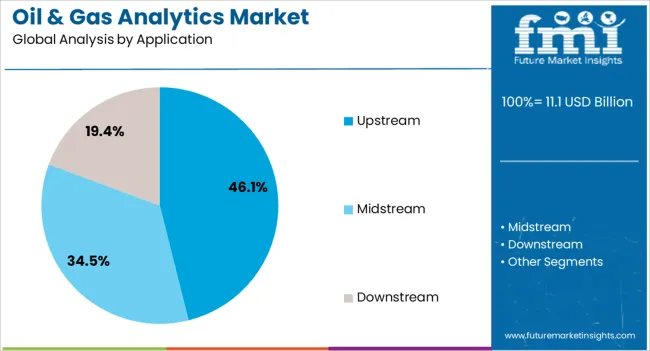
The Upstream application segment is anticipated to contribute 46.1% of the oil and gas analytics market revenue in 2025, positioning it as the leading use case. This segment has experienced growth due to the complexity and data intensity of exploration and production activities.
Analytics have been increasingly utilized for reservoir modeling, drilling optimization, production forecasting, and equipment monitoring. Operators focus on upstream analytics to improve operational efficiency and extend the lifespan of assets while minimizing environmental impact.
The segment’s prominence is reinforced by ongoing exploration in challenging environments and the adoption of digital twins and real-time monitoring. With upstream activities continuing to demand sophisticated data solutions, this segment is expected to retain its market dominance.

The Professional services segment is projected to hold 39.4% of the oil and gas analytics market revenue in 2025, establishing itself as the largest service category. This segment’s growth is driven by the complex nature of analytics implementation which requires expert consulting, system integration, and ongoing support.
Oil and gas companies often rely on professional service providers to tailor analytics platforms to their unique operational challenges. These services include data management, advanced algorithm development, and training to ensure effective use of analytics tools.
As operators pursue digital transformation, the need for professional expertise in change management and technology adoption has increased. The expanding scope of analytics projects and demand for continuous optimization are expected to sustain the growth of the Professional services segment.
The oil and gas analytics market is shaped by predictive maintenance, exploration modeling, real-time midstream monitoring, and downstream process optimization. These dynamics highlight its expanding role in ensuring efficiency, safety, and profitability across the value chain.
The oil and gas analytics market is experiencing strong demand for predictive maintenance solutions as operators aim to minimize downtime and extend asset life. Analytics-driven predictive models process data from sensors, machinery, and drilling equipment to detect faults before they escalate. By preventing unplanned shutdowns, companies can reduce maintenance costs while ensuring production continuity. This dynamic is particularly important in offshore operations, where repair expenses and risks are significantly higher. The integration of machine learning algorithms with historical and real-time datasets has further enhanced fault detection accuracy. As a result, predictive maintenance is becoming a critical investment area for operators seeking operational reliability and efficiency.
Analytics platforms are gaining traction in exploration and reservoir modeling due to their ability to interpret vast volumes of seismic and geological data. These solutions help geoscientists and engineers identify drilling targets with higher accuracy, reducing exploration risks and improving recovery rates. The use of advanced reservoir simulation models also supports better management of existing fields, maximizing output from mature assets. Oil and gas firms are relying on these analytics-driven insights to guide investment decisions and streamline exploration campaigns. The demand for improved reservoir performance under cost-sensitive conditions is driving wider adoption, making exploration analytics a cornerstone of market growth.
In midstream operations, oil and gas analytics is being applied to monitor pipelines, terminals, and storage facilities with greater precision. Real-time data collection and analytics allow operators to identify flow disruptions, leakages, or pressure anomalies early, ensuring both safety and efficiency. This capability has become critical in reducing risks associated with environmental hazards and operational bottlenecks. The deployment of analytics tools also assists in optimizing logistics, improving scheduling, and ensuring compliance with stringent safety regulations. By supporting predictive pipeline monitoring and automated alerts, analytics in the midstream sector is transforming operational practices, providing measurable improvements in both cost management and risk reduction.
The downstream segment is adopting analytics for process optimization, yield enhancement, and energy efficiency improvements across refineries and petrochemical facilities. Analytics enables operators to analyze production variables in real time, identifying inefficiencies and adjusting operations to improve throughput. These tools also support blending optimization, emissions monitoring, and compliance reporting, which are vital in competitive refining environments. With growing complexity in downstream operations, the ability to integrate diverse data sources into actionable insights has become crucial. By ensuring consistent product quality and reducing wastage, analytics is helping downstream operators maintain profitability while responding to evolving market demands and regulatory requirements.
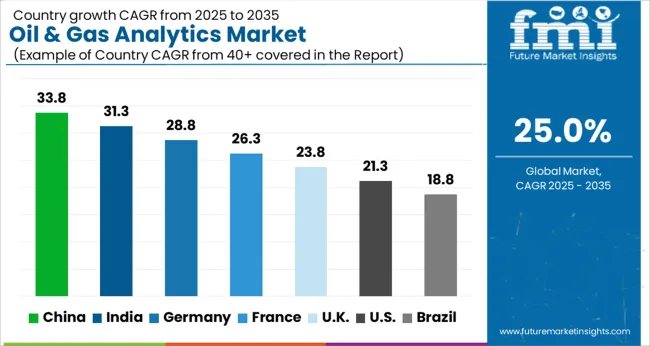
The oil and gas analytics market is projected to grow globally at a CAGR of 25.0% from 2025 to 2035, supported by increasing digital adoption, rising energy demand, and the need for operational efficiency across upstream, midstream, and downstream operations. China leads with a CAGR of 33.8%, driven by large-scale adoption of predictive analytics, AI-integrated exploration tools, and government-backed energy digitalization initiatives. India follows at 31.3%, supported by its growing energy demand, investments in upstream projects, and reliance on analytics for refining and logistics optimization. France posts 26.3%, fueled by analytics integration in petrochemical and LNG projects.
The United Kingdom grows at 23.8%, aided by offshore North Sea analytics adoption and regulatory compliance requirements, while the United States records 21.3%, reflecting a mature market focusing on optimizing shale production, midstream logistics, and refinery yield improvements. This growth outlook emphasizes Asia’s dominance in analytics-driven oil and gas transformation, while Europe advances with efficiency-led adoption, and the USA maintains steady reliance on digital tools for operational optimization.
China is projected to grow at a CAGR of 33.8% during 2025–2035, far above the global baseline of 25.0%, reflecting its leadership in digital transformation within the oil and gas sector. Between 2020–2024, the CAGR stood at 28.2%, supported by initial investments in predictive analytics, drilling optimization tools, and digital twins across state-owned enterprises. The acceleration in the next decade is attributed to the government’s strong emphasis on energy security, large-scale upstream digitalization projects, and AI-based reservoir management solutions. China’s focus on combining analytics with renewable integration and LNG import operations further enhances its momentum, positioning it as the global frontrunner.
India is forecasted to expand at a CAGR of 31.3% from 2025–2035, outperforming the global benchmark of 25.0%. During 2020–2024, its CAGR was 26.7%, fueled by rising investments in refining capacity, growing domestic energy demand, and adoption of analytics for midstream logistics. The higher growth in the following decade is tied to increased offshore exploration, adoption of IoT-enabled predictive tools, and stronger government support for digital energy initiatives. India’s refining and petrochemical expansion programs, combined with partnerships between global analytics firms and domestic oil companies, will continue to strengthen its growth trajectory and regional competitiveness.

France is set to grow at a CAGR of 26.3% during 2025–2035, above the global average of 25.0%. From 2020–2024, its CAGR was 22.8%, driven by early-stage digitalization in refineries and LNG terminals. The improved growth outlook is linked to broader adoption of analytics in carbon management, emissions tracking, and process efficiency programs within petrochemicals. Regulatory pressure and regional commitments toward low-carbon operations have accelerated analytics demand, particularly in refining and downstream processes. With enhanced adoption of AI-based process control and compliance-driven digital platforms, France continues to build steady momentum in oil and gas analytics adoption.
The United Kingdom is expected to grow at a CAGR of 23.8% during 2025–2035, slightly below the global average of 25.0%. During 2020–2024, its CAGR was 20.1%, supported by North Sea digitization efforts and analytics integration in offshore operations. The rise in growth is explained by deeper adoption of analytics for decommissioning projects, compliance with energy transition goals, and the expansion of predictive maintenance tools in offshore platforms. Regulatory frameworks encouraging efficiency gains and emission reductions are also contributing to higher adoption. This progress underlines the UK’s ability to leverage analytics in balancing energy security and decarbonization goals.
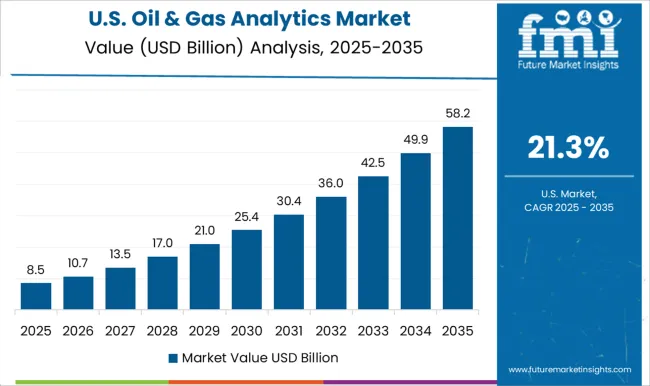
The United States is projected to record a CAGR of 21.3% during 2025–2035, slightly below the global average of 25.0%. Between 2020–2024, the CAGR was 18.9%, reflecting steady adoption across shale basins and refining operations. The improvement in the next phase is driven by shale optimization programs, digital integration in midstream pipelines, and advanced analytics for refining yields. Although growth is moderate compared to Asia, the USA remains a critical market due to its large installed base and consistent investment in digital solutions. Its focus on operational optimization and strategic efficiency ensures analytics remains central to long-term competitiveness.
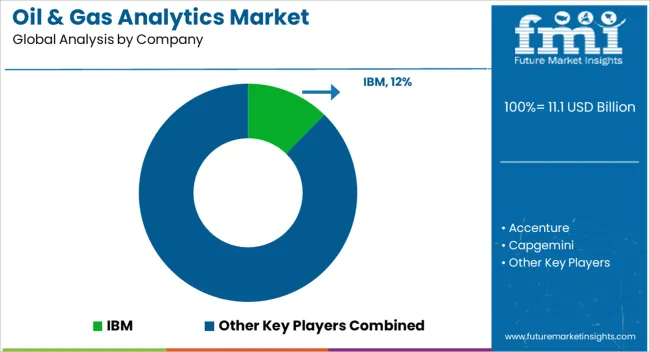
The oil and gas analytics market is highly competitive, with global technology leaders and analytics providers delivering digital solutions across upstream, midstream, and downstream operations.
Accenture leverages its consulting and digital integration expertise to support oil and gas firms in adopting scalable analytics frameworks. Capgemini emphasizes data transformation services, enabling predictive insights for refining and energy management.
Cisco provides secure network and data infrastructure critical for analytics deployment, while Cognizant delivers tailored solutions in asset performance and process efficiency. Deloitte focuses on advisory-led analytics strategies to drive operational efficiency across global operators.
| Item | Value |
|---|---|
| Quantitative Units | USD Billion |
| Deployment | On-premise and Hosted |
| Application | Upstream, Midstream, and Downstream |
| Service | Professional, Cloud, and Integration |
| Regions Covered | North America, Europe, Asia-Pacific, Latin America, Middle East & Africa |
| Country Covered | United States, Canada, Germany, France, United Kingdom, China, Japan, India, Brazil, South Africa |
| Key Companies Profiled | IBM, Accenture, Capgemini, Cisco, Cognizant, Deloitte, Hewlett Packard Enterprise, Hitachi, Microsoft, Oracle, SAP, SAS Institute, Tableau, Teradata, TIBCO |
| Additional Attributes | Dollar sales, share, regional adoption trends, competitive benchmarking, regulatory impact, technology preferences, pricing dynamics, upstream vs downstream demand, and growth opportunities in digital platforms. |
The global oil & gas analytics market is estimated to be valued at USD 11.1 billion in 2025.
The market size for the oil & gas analytics market is projected to reach USD 103.6 billion by 2035.
The oil & gas analytics market is expected to grow at a 25.0% CAGR between 2025 and 2035.
The key product types in oil & gas analytics market are on-premise and hosted.
In terms of application, upstream segment to command 46.1% share in the oil & gas analytics market in 2025.






Our Research Products

The "Full Research Suite" delivers actionable market intel, deep dives on markets or technologies, so clients act faster, cut risk, and unlock growth.

The Leaderboard benchmarks and ranks top vendors, classifying them as Established Leaders, Leading Challengers, or Disruptors & Challengers.

Locates where complements amplify value and substitutes erode it, forecasting net impact by horizon

We deliver granular, decision-grade intel: market sizing, 5-year forecasts, pricing, adoption, usage, revenue, and operational KPIs—plus competitor tracking, regulation, and value chains—across 60 countries broadly.

Spot the shifts before they hit your P&L. We track inflection points, adoption curves, pricing moves, and ecosystem plays to show where demand is heading, why it is changing, and what to do next across high-growth markets and disruptive tech

Real-time reads of user behavior. We track shifting priorities, perceptions of today’s and next-gen services, and provider experience, then pace how fast tech moves from trial to adoption, blending buyer, consumer, and channel inputs with social signals (#WhySwitch, #UX).

Partner with our analyst team to build a custom report designed around your business priorities. From analysing market trends to assessing competitors or crafting bespoke datasets, we tailor insights to your needs.
Supplier Intelligence
Discovery & Profiling
Capacity & Footprint
Performance & Risk
Compliance & Governance
Commercial Readiness
Who Supplies Whom
Scorecards & Shortlists
Playbooks & Docs
Category Intelligence
Definition & Scope
Demand & Use Cases
Cost Drivers
Market Structure
Supply Chain Map
Trade & Policy
Operating Norms
Deliverables
Buyer Intelligence
Account Basics
Spend & Scope
Procurement Model
Vendor Requirements
Terms & Policies
Entry Strategy
Pain Points & Triggers
Outputs
Pricing Analysis
Benchmarks
Trends
Should-Cost
Indexation
Landed Cost
Commercial Terms
Deliverables
Brand Analysis
Positioning & Value Prop
Share & Presence
Customer Evidence
Go-to-Market
Digital & Reputation
Compliance & Trust
KPIs & Gaps
Outputs
Full Research Suite comprises of:
Market outlook & trends analysis
Interviews & case studies
Strategic recommendations
Vendor profiles & capabilities analysis
5-year forecasts
8 regions and 60+ country-level data splits
Market segment data splits
12 months of continuous data updates
DELIVERED AS:
PDF EXCEL ONLINE
Oil & Gas Analytics Market Growth – Trends & Forecast 2025 to 2035
Midstream Oil & Gas Analytics Market Size and Share Forecast Outlook 2025 to 2035
Oil & Gas Electrification Market Size and Share Forecast Outlook 2025 to 2035
Oil & Gas Infrastructure Market Size and Share Forecast Outlook 2025 to 2035
Oil & Gas Carbon Capture and Storage Market Size and Share Forecast Outlook 2025 to 2035
Oil & Gas Data Management Software Market Size and Share Forecast Outlook 2025 to 2035
Oil & Gas Terminal Automation Market Growth – Trends & Forecast 2025-2035
Oil and Gas Seal Market Size and Share Forecast Outlook 2025 to 2035
Oil and Gas Sensor Market Forecast Outlook 2025 to 2035
Oil and Gas Pipeline Coating Market Forecast and Outlook 2025 to 2035
Oil and Gas Field Services Market Size and Share Forecast Outlook 2025 to 2035
Oil and Gas Accumulator Market Size and Share Forecast Outlook 2025 to 2035
Oil and Gas Hose Assemblies Market Analysis - Size, Share, and Forecast Outlook 2025 to 2035
Oil And Gas Electric Submersible Pump Market Size and Share Forecast Outlook 2025 to 2035
Oil and Gas Fittings Market Growth - Trends & Forecast 2025 to 2035
Oil and Gas Valve Market Growth – Trends & Forecast 2024-2034
Oil and Gas Data Monetization Market
Oil and Gas Pipeline Management Software Market
Oil And Gas Security And Services Market
Gas Fired Boiler Market Size and Share Forecast Outlook 2025 to 2035

Thank you!
You will receive an email from our Business Development Manager. Please be sure to check your SPAM/JUNK folder too.
Chat With
MaRIA